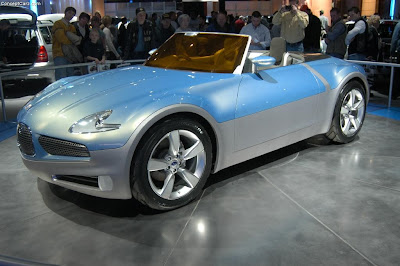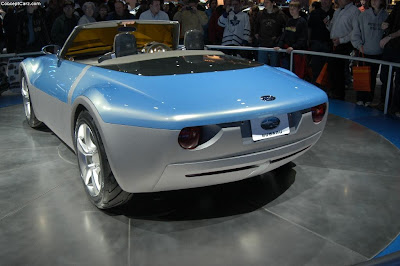
 The electroluminescent speedometer brushes 200 kph as we hurtle down the back straight of a secluded, banked-oval test track near Turin, Italy. From the seat to my left, snapper Bramley captures the moment with his Canons. To my right is Fabrizio Giugiaro, director of styling of Italdesign and the primary creative force behind the outrageous machine we're riding in. I'm the man in the middle. That's correct, because a central driving position is one of many fascinating design aspects of the Italdesign Quaranta.
The electroluminescent speedometer brushes 200 kph as we hurtle down the back straight of a secluded, banked-oval test track near Turin, Italy. From the seat to my left, snapper Bramley captures the moment with his Canons. To my right is Fabrizio Giugiaro, director of styling of Italdesign and the primary creative force behind the outrageous machine we're riding in. I'm the man in the middle. That's correct, because a central driving position is one of many fascinating design aspects of the Italdesign Quaranta."200K! Not bad for a concept car, no?" Giugiaro is engaging, passionate, fashion-model handsome, and funnier than Letterman. The engine blares and blats under full throttle, yet as we glide this futuristic, fighter-jet canopied doorstop to a halt, the expected guttural thrum from an idling four-cam V-10 is noticeable by its absence. The only noise I hear is the distant whir of a cooling fan mixed with miscellaneous electronic fizzes. "It's wrong. All wrong," Fabrizio says. "The car is running, but there is no sound. Crazy!"
That's because this turntable star of the 2008 Geneva motor show shares its basic philosophy not with the Lamborghini Gallardo that Giugiaro also designed, but with that poster-child of all hybrids, Toyota's white-hot-selling Prius. Welcome to the hybrid-powered, all-wheel-drive, mid-engine exotic sports car.
The Quaranta is overwhelming in concept, execution, and design detail. And unlike so many show ponies (that look racy underneath an auto show's bright lights, but in reality are motivated by a golf-cart motor and a few 12-volt batteries), this Italdesign creation is a fully engineered runner. And we're here flogging it for all it's worth-many millions, no doubt-less than 60 days after its worldwide debut in Geneva.
Massage the right button, and the rear decklid opens to reveal a powertrain cribbed from what we know as the Lexus RX 400h. Italdesign and Toyota have an ongoing relationship; their first project, the Toyota Volta concept of 2004, laid the groundwork for this far more outrageous interpretation of the green exotic. Although the Toyota sport/utility provides its 3.3-liter DOHC V-6 engine, electric-motor assist hardware, continuously variable transmission, all-wheel-drive system, and a bucketload of electronics (including the IP-mounted display that shows when the power is flowing to and from the motors and battery pack), the rest of the Quaranta was designed, engineered, and built by hand from the ground up at Italdesign's Moncalieri, Italy, facilities.
With its modified, side-exit exhaust and reprogrammed engine-management systems, this 3100-pound ecomissile is rated at 268 total horsepower. Battery charging is assisted by Toyota's regenerative braking system and also by solar panels affixed to the car's front and rear horizontal surfaces. As functional and styling elements, the panels generate an additional 250 watts of free power, so long as the sun is shining.
The Quaranta's most striking angle is from the bird's-eye view, straight overhead. From there, it appears more a piece of modern art-pure graphic sculpture-than an automobile. The paint is a warm, matte-finish metallic silver, which adds another industrial-design element. At 175.2 inches long, the Quaranta splits the difference between the Gallardo and big brother Murcielago.


 Strong, lightweight carbon fiber is employed for the monocoque chassis, with various aluminum and steel substructures. The bodywork is a combination of composites and aluminum. No off-the-shelf MacPherson struts here; the Quaranta uses racing-style stuff, in the form of custom-made multiple suspension links and pushrod actuated coil-over shock absorbers. The battery packs are mounted between the engine compartment and the cabin. The twin fuel tanks hold a total of about 16 gallons of gas and offer a claimed range of over 600 miles. That equates to around 37.5 mpg, a far sight better than a Murcilago.
Strong, lightweight carbon fiber is employed for the monocoque chassis, with various aluminum and steel substructures. The bodywork is a combination of composites and aluminum. No off-the-shelf MacPherson struts here; the Quaranta uses racing-style stuff, in the form of custom-made multiple suspension links and pushrod actuated coil-over shock absorbers. The battery packs are mounted between the engine compartment and the cabin. The twin fuel tanks hold a total of about 16 gallons of gas and offer a claimed range of over 600 miles. That equates to around 37.5 mpg, a far sight better than a Murcilago.
The massive glass canopy opens to reveal a dazzling cockpit that combines a future-tech look with leather-covered surfaces as only Italians can do them. "The easiest way to enter is to just kind of walk into it," says Giugiaro. And he's right. Step over the sill from either side onto the floor in front of the passenger seat and then sit down into the driver's seat. Having many controls mounted into the flat-bottomed steering wheel is a design element Fabrizio and his legendary father, Giorgetto, have employed many times. Thumb the power button, and the gauges and camera monitors come to life, as do the electric motors. But, as is typical of hybrids, there is no starter. The view through the huge, single piece of tinted glass is unobstructed and otherworldly. Now I know what fish and fighter pilots feel like.
As I ease the Quaranta toward the entrance to the track, all notions of the "photo speed only" mandate, so typical of concept car drives, go straight out the canopy, while Giugiaro instructs me to slam my foot to the floor. The gas engine lights and spins to max revs, the CVT feeding in power as speed climbs. We do a couple wristwatch 0-to-60 runs and get mid-to-high five-second runs with three aboard. It's not crazy fast, but impressively quick. There's none of the crashing and banging so typical of these handbuilt one-offs, as chassis insulation and such are seldom bothered with. The V-6 exhaust tone could pass for that of a V-12, but would never be mistaken for an engine with eight or 10 cylinders.


 Italdesign put a considerable amount of time into the Quaranta's aerodynamics, and it shows. It's rock-flat stable at 120 mph, feeling well trimmed and exhibiting no lift and just enough downforce to keep it planted. Giugiaro admits that more is possible here, because of course it's not a production model, although it was treated much that way in the design process. The hushed sound, flat surfaces, and lack of exterior mirrors or wings mean wind noise is extremely low.
Italdesign put a considerable amount of time into the Quaranta's aerodynamics, and it shows. It's rock-flat stable at 120 mph, feeling well trimmed and exhibiting no lift and just enough downforce to keep it planted. Giugiaro admits that more is possible here, because of course it's not a production model, although it was treated much that way in the design process. The hushed sound, flat surfaces, and lack of exterior mirrors or wings mean wind noise is extremely low.
After lapping the bowl several times, the Quaranta's creator leads me toward the track's skidpad. G-force runs-in a concept car? Oy. I crank the wheel and begin running an imaginary 200-foot circle. This thing has major grip. No way could I get it to push out without destroying the custom tires. I then try some low-speed transitions. Next thing I know, I'm flinging it side to side like a kart. Wish Reynolds and Mortara were here-nobody would believe this.
I point the car toward a nearby transporter, but Giugiaro again waves me off. "I want to see it on the road. It has never been driven out in the world before. You drive it back to Italdesign." Wait a minute. Handbuilt concept car costing millions. What if I stuff it? No official license plates. No registration. What about insurance? This thing is as street legal as the Space Shuttle. "This is Italy," Giugiaro reminds. "The rules for such things aren't so clear here. So we do what we want." He settles into the left seat to help me watch the cameras, and the car's flanks as we prepare to hit the autostrada. As you'd expect, the locals went freako over seeing this four-wheeled spacecraft on Northern Italy's public roads. Kids jumped and pointed. Cell-phone cams clicked. Vehicles moved out of the way for us, then up, then back, then around. Soon we relaxed and drove it like a car, if not exactly a normal one. The most interesting moment? Pulling through a toll booth. The cointaker looked as if he was seeing Martians abducting Enzo Ferrari, but never said a word.
As we recover from the experience of piloting the Quaranta, Fabrizio Giugiaro's mind is racing ahead somewhere else. "After watching it in motion, I see things. The camera monitor locations are wrong. There are a few lines I wish I had changed. Maybe the surface of the paint should be different. Other things, too. It's time to do something new."













